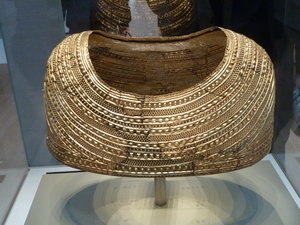Advertisement
Published: November 14th 2012

 London
London
British Museum - the Gold Cape Time flies when you are having fun or so they say. Time has flown for us and it is the last day of our visit to London. What a time we have had. Our colds still seem to be well and truly with us. We are still sneezing, coughing and spluttering and they are lingering on for some reason. We need some sun to get rid of them. And we are truly exhausted. We thought Rome exhausted us with all that walking between the sights but London is something else. So many landmarks to see - and what a sky line. What a city. The problem is that there is so much distance between one attraction and the next one. Even using the underground everything seems so spread out.
A friend told me that she wished she could spend two weeks every year doing the culture of London and I can perhaps see why after our short trip. So much to do and see and so little time to do it. You can keep going back and finding things to do. We even missed the Red London sightseeing bus trip and a trip down the Thames. And then there was

 British Museum
British Museum
Assyrian wall decorations the Globe theatre and Tower Bridge's inner workings. We missed the Victoria and Albert museum, the Science museum and a handful of other things.
As our London Pass had run out our first job was to make the decision - to buy an Oyster Card and top it up or not. The other alternative was to buy a day pass at the station. For the underground and travel for Zones 1 -4 the cost would be £7.70 which seemed a bargain and a better option than the Oyster Card. The day pass won. It is possible to buy the off peak at Abbey Wood at 9.23 which is the time the last on peak train leaves the station. We joined the queue of others waiting to buy the same off peak tickets. They seemed very popular with tourists.
As usual the train was full. We found this quite a surprise as back home everyone is in work by 9.00 and once the school run is over the roads are empty. Here the day seems to start anytime between 6 in the morning and 10.30. A different pace of life to North Wales. Not sure it would suit us

 Briitsh Museum
Briitsh Museum
Copy of Sutton Hoo mask living here - far too hectic a pace of life. We prefer the quiet slow pace of back home. London is OK for a trip but living here would be hell. Although I guess for some people it would be heaven.
Our train trundled into town, after which we went on the Underground to Tottenham Court Road. This took us to our first stop - the British Museum. An impressive building with a stunning exterior and interior. Even without the artifacts it was stunning.
We had made a list of items and artifacts we wanted to see. By making the list we hoped to see everything and miss nothing of importance. . But there were so many rooms to get around and so many people. It must have been the busiest tourist attraction we had been to see over the short break. Perhaps this was because it was free to the public. I wondered why we didnt charge entry fees as in the EU every museum seems to charge the public to visit. Here we depended on donations.
The permanent collection numbers eight million works although not all are exhibited. There was no way we would get

 British Museum
British Museum
Egyptian sculptureto see a quarter of those displayed. The museum was established in 1753 and houses articles from all countries documenting human history and culture. We did ponder on the moral dilemma of taking artifacts from their home countries and displaying them in museums all round the world. But came to the conclusion that without this interference and collecting mania many items would now be destroyed or lost. At least we have preserved much of the past and for that we must be thankful.
It is such a wonderful museum that it was hard to know where to start. Our first stop was the Egyptian rooms where there are over 100,000 objects. We certainly did not see all 100,00. There were large scale Statues of Egyptian pharoahs which lined room after room. There were monumental sculptures in the middle and friezes along the edges of the walls some showing young nubile egyptian women. We saw busts of Ramesses II and Amenhotep III - all names that ring bells deep in the memory. There were images we had seen in many a book. In two rooms the Rosetta Stone was displayed - the original and the copy. Both were fantastic pieces
and it was easy to imagine how exciting it must have been to unearth it.
The collection of Egyptian mummies is spectacular. Everything to do with the cult of the dead was there. A highlight for us was the mummy with a portrait of a Roman man on it. Most mummy portraits are no longer attached to the mummy itself so this is a very special piece. Most have not survived so it was a pleasure to see this particular piece. We had watched a programme on TV a few weeks ago which showed this mummy and we made a special effort to see it.
What else was spectacular? The Assyrian rooms where the museum had displayed antiquities from the Middle East mainly the cities of Nimrud and Nineveh. Carved reliefs covered wall after wall so intricate in design. Flat compared to Greek sculpture but beautiful in their simplicity. Huge statues that were part of impressive palace complexes and display cases full of Minoan pottery - brown and black. Heavily painted with bull running scenes.
One room contained the Elgin marbles, another full of Roman coins, written tablets from Hadrians wall, artifacts from Roman home life and

 Bristish Museum
Bristish Museum
a bevy of beauties hoard after hoard dug up by metal detectorists.
The Bronze and Dark Age fascinated us and we had earmarked several must do items. - the Lewis Chess set, beautifully carved black and white , the Sutton Hoo treasure - the face mask had haunted me for years. It stared back at me out of its display case. On the way we saw torques of solid gold, gold work so exquisite that the art of the goldsmith was clear to see. Ropes of gold shining brightly as if new and just purchased from the jewellers shop. Precious and semi-precious stones set into rings and necklaces.
Our favourite item though was the Mold Gold Cape. The reason for wanting to see this was that we live fairly close to Mold where the cape was found and I work just a few hunded yards from the burial site it was excavated from. The cape is solid gold and was found in 1833. It is thought to be ceremonial and has a religious purpose. Sometimes we think it should be returned home to Wales but there is very little likelihood of that. It is a stunning piece of gold work. Whoever said

 British Museum
British Museum
The Rosetta Stone that the Dark Ages were dark was wrong.
Lunch was spent in the British museum cafe where we ate chicken, vegetables and potatoes and lamb and potatoes. Rather nice but a touch expensive for what it was. We have visited many museums in the world but this has to be the best with a fabulous collection with something for everyone. Whatever your taste there was something on offer
The afternoon was spent in the National Gallery another lovely building on the edge of Trafalgar Square. What had we intended to see ? Firstly The Ambassadors a painting by Hans Holbein the Younger - it was a well executed painting, full of detail and of course most visitors stand in front of it trying to view the skull in the foreground. We saw Monet's paintings of his garden at Giverny and of Paris in general, Constables Hay Wain and Salisbury Cathedral. I have never been a lover of Constable - his paintings have felt a little bit chocolate box for me but have to say I was more interested in his paintings now having seen them "in the flesh". Turners were in abundance - The Fighting Temeraire and Rain, steam and speed. Himself is not fond of Turner but I rather liked the moody skies and the impressionism of the subject. All art was there from early flat altarpieces naive in quality right up to Van Gogh's sunflowers.
Of course we missed something really important - The Anolfini Wedding by Jan Van Eyke. Gosh another reason to come back to London.
We had planned to come home after our visit to the museums but decided at short notice to continue on to Kent. We booked three days at the Caravan and Camping Club site in Canterbury. Cheaper than the Caravan Club this club offers discounts for golden oldies. Odd how the savings equate to a fish supper, a fill of petrol or a couple of nights camping. . The biggest problem was where to go - Canterbury definately but many other places are closed for the winter which is a shame. We did however find that Ightham Mote and Leeds Castle were open so it was decided that these two would be our next destinations.
Advertisement
Tot: 0.077s; Tpl: 0.015s; cc: 12; qc: 25; dbt: 0.0523s; 1; m:domysql w:travelblog (10.17.0.13); sld: 1;
; mem: 1.1mb













